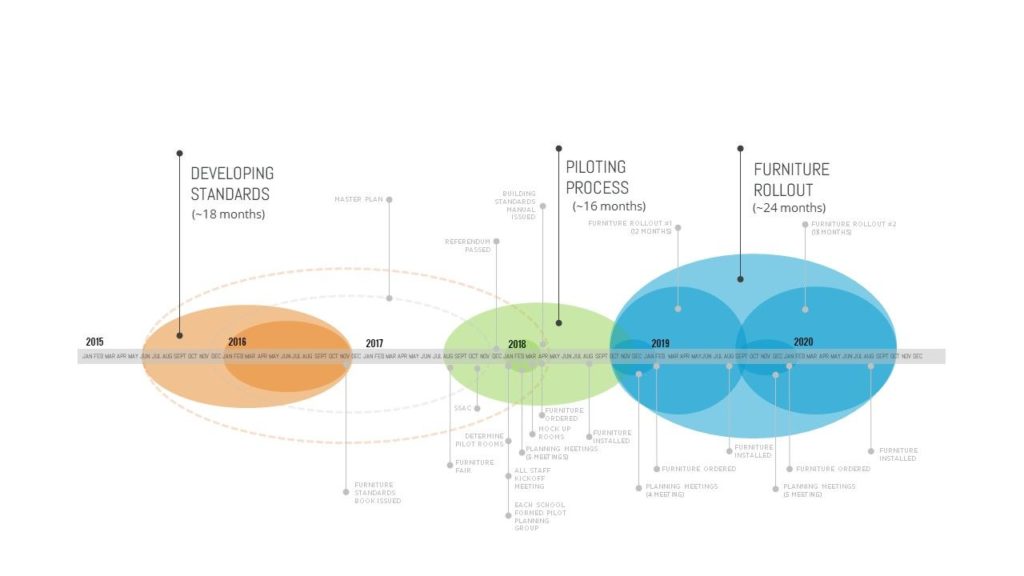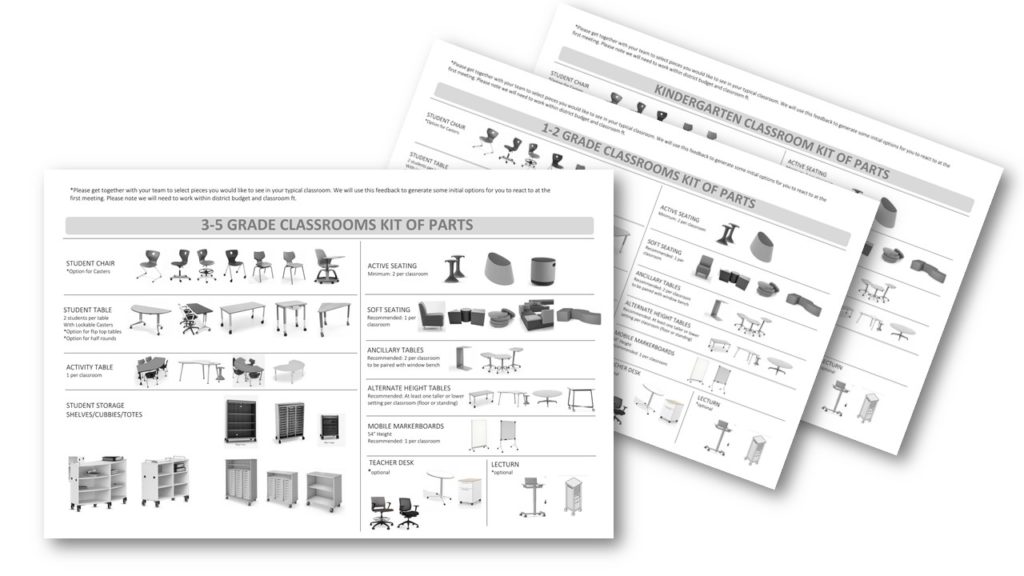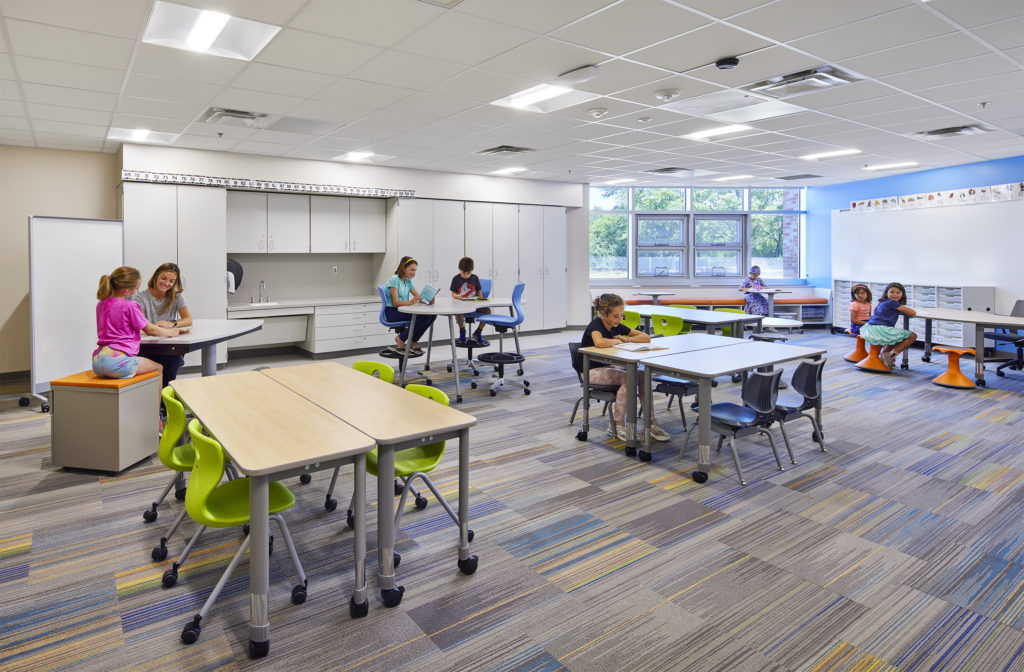Are you looking for a roadmap to standardize furniture selection and implementation in your school district? The 5,000-student PreK through 12th grade St. Louis Park Public School District (a first-tier suburb in Minneapolis, Minnesota) embarked on a collaborative district-wide building standards endeavor, specifically focusing on furniture standardization efforts at the elementary school level. The process was initiated and directed by Thomas Bravo, Facilities/Construction/Health & Safety Manager of the District. Four architectural firms were brought together to fulfill the District’s objective to create sustainable and energy-efficient building material standards and standardization for 21st century classroom and furniture design.
The District passed a $100.9 million construction referendum with specific funds allocated to furniture. The unique partnerships, standards manual, and pilot classrooms laid the groundwork for successful project outcomes. The process involved three major steps: developing standards; ‘mock-up’ piloting; furniture roll-out.

Figure 1: Diagram of the Project Roadmap for Furniture Standardization for St. Louis Park Schools
FURNITURE STANDARDIZATION
Standardization took 18 months, with intensity the latter 12 months. With assistance from the architectural firms specializing in educational facilities, a collaboration of unlikely partnerships was formed to work together for a successful solution. The reason the District established standards was to streamline ordering processes, facilitate ease of installation, pursue quality, strengthen warranties/maintenance, bring consistency between schools, manage inventory, provide equity across schools, and enhance furnishings for 21st century learning.
Vetting furniture was essential for a successful outcome. This involved selecting dealer partners that have school experience, reputable credentials with two of the architectural firms involved, and have products that fit the District’s purpose/principles.
Guiding principles were created to ensure furniture purchased would provide for choice (i.e., support the unique learner), embrace ergonomics (i.e., for good posture, brain connectivity, and movement), support varied activities (i.e., offering multiple approaches for delivering/receiving learning), be flexible (i.e., support moveability, adjustability, and portability), and be support-tools (i.e., provide tools for teachers/learners). Vetting furniture was essential for a successful outcome. This involved selecting dealer partners that have school experience, reputable credentials with two of the architectural firms involved, and have products that fit the District’s purpose/principles. Dealers were selected based on product quality, warranty support, state contract compliance, and approval by the District’s ergonomic and risk assessment consultant.
The furniture standards manual was created as a catalog (i.e., hard-bound as well as hyperlinked pdf). Though standardized, the manual allowed for personalization by school site. A ‘Table of Contents’ divides the manual in three main categories: ‘Introduction’ that includes the mission, purpose, and procedures; ‘Product Listing’ that includes chairs, tables, storage, tools, and outdoor furniture; ‘Appendix’ that includes contact information, order form examples, idea starters, and ergonomics protocols. Specifically, the ‘Product Listing’ provides information about the product type, gives multiple options from different approved manufacturers, and lists basic specification information (e.g., color options, budget pricing, dealer information, selection guides).

Figure 2: Diagram of furniture selection guide example.
The ‘takeaways’ realized from the standardization process included the powerful value of firms collaborating together and forming unlikely partnerships, a streamlined design process, standards evolving with planned updates, and less downtime and reduction of work orders for repairs.
PILOTING PROCESS
To assure a successful furniture rollout, the District engaged in a 16-month piloting process to guide future furniture and classroom modernization (i.e., including testing finishes, casework/storage, technology) investment decisions. Monthly milestones included:
- A back-to-school ‘furniture fair’ organized by vendors for staff viewing;
- Student council leadership feedback opportunities on furniture preferences;
- Voter approval for funds appropriation;
- Two pilot classrooms allocated at each elementary school for a K-2 classroom, 3-5 classroom, and special education room;
- All-staff kick-off meeting to introduce the process, review furniture guiding principles, and assign ‘homework’ involving questionnaires and resource materials;
- Site-based participatory planning groups (i.e., school principal, teacher representatives, and specialists);
- Pilot classroom planning meetings (i.e., introductions, teacher homework presentations, design layout workshops, product testing room ‘mock-ups’ to help teachers visualize new ideas and tools for learning);
- Pilot furniture ordering and installation, along with teacher/student/vendor feedback and all-staff tours.
Here are the prominent ‘takeaways’ realized from the pilot process:
- Furniture Planning: Start planning 18 to 24 months before the furniture rollout. Emphasize to users to “…try something different…” and plan for pilot room adjustments after the piloting period. Establish guiding principles from which to evaluate furniture. Coordinate installation early-on with contractors.
- Architectural: Provide cabinet doors versus open shelves for clutter management, porcelain enamel markerboards versus glass, mobile smartboards for flexibility, window seats, and carpeted floors.
- Furniture: Provide kidney-shaped tables versus other shapes to accommodate six students, and chairs with casters at all grade levels. Omit underutilized flip-tops on chairs and handles on mobile storage. Go with the theme of ‘less is more.’
FURNITURE ROLLOUT
After approval of the furniture standards and classroom pilot ‘mock-ups,’ the District engaged in the actual rollout of furniture. It was a major accomplishment to have the District’s staff, students, administrators, school board members, the architectural firms, and the approved vendors in agreement to proceed with the final step.
The rollout involved two phases of furnishing the schools. Furniture was standardized by school, requiring each school to select from the standards manual, yet allowing for choice/personalization of chair and table selections for each school. Grade level furniture groupings consisted of Kindergarten, Grades 1-2, and Grades 3-5, allowing more flexibility for accommodating ‘bubble’ classes. A planning group was established at each school, which included the school principal, one teacher representing each grade, and specialists (i.e., special education, speech, music, EL, reading, math intervention, media center).
For Phase 1, five meetings were held in six months (i.e., October through February and August) to establish planning groups, explain the process and teachers roles, review guiding principles, and work with grade level teams to fill-out ‘kit-of-parts’ worksheets for classroom furniture items. Further, three design workshops were conducted, final project specifications manuals and drawings were prepared and issued to furniture vendors, and orders were placed. Finally, furniture was installed at the sites, with architectural firm oversight.
After each phase, some informal training was conducted and a furniture manual was issued as a tool for teachers/students to use the furniture as intended. The manual included product listings, plan layouts, contact information, policies/procedures for additional purchases and warranty replacements. School principals found the manual very helpful as a reference for confirming correct ‘kit-of-parts’ installations.

Figure 3: Diagram of ‘kit-of-parts’ worksheet for site-based furniture selection.
For Phase 2, one more meeting was added from the Phase 1 rollout to engage further with District specialists. Over the seven-month duration (i.e., September through February and August), the same activities occurred as in Phase 1.
The ‘takeaways’ realized from the furniture rollout were that multi-grade groupings of furniture can work with adjustable-height seating, design guidelines should be kept handy for checking selection conformance, training time should be allowed for users, a user ‘sign-off’ process during design and piloting should be implemented, piloting positively impacts furniture decisions to shape classroom layouts, and that casters should be provided on the majority of chairs at all grade levels.

As St. Louis Park Public School District reflects on the effort and solutions for their district-wide building standards and furniture standardization, the outcomes achieved were truly successful in fulfilling the objective to create sustainable and energy-efficient building material standards and ‘future-ready’ ergonomic furniture standards for 21st century classroom design. For your school district, now may be the time to prepare your roadmap and engage in a process to standardize furniture selection and implementation; we would be happy to lead, guide, and inspire you in this journey!

